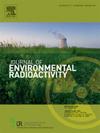Improved soil-to-plant transfer factors for 99Tc and 79Se in natural and agricultural ecosystems
IF 1.9
3区 环境科学与生态学
Q3 ENVIRONMENTAL SCIENCES
引用次数: 0
Abstract
Geological Disposal Facilities (GDFs) are the preferred option for the disposal of high- and medium-level nuclear waste but environmental assessments for GDFs are complex. Models of transfer into the biosphere for radioisotopes that occur in nuclear waste rely on estimated Transfer Factors (TFs) that often have high levels of uncertainty and only exist for a few species. Here, using two key radioisotopes found in nuclear waste, we show that taxonomic analyses and phylogenetically based trait prediction (PTP) can be used to both reduce uncertainty in current estimates of soil-to-plant TF and to predict them for the many species with no measurements. We grew 61 species of plants selected to provide a phylogenetically informed sample, measured their uptake of 99Tc and 75Se, and reconstructed their possible evolutionary relationships using gene sequence information. The uptake of Tc and Se isotopes by plants was correlated, and for Tc was more similar within plant groups than between them and included significant taxonomic and phylogenetic influences. We use these findings to suggest improved soil-to-plant Transfer Factors (TFs) for99Tc and 79Se. We suggest that the approaches we used might be useful for a range of radionuclides, in both improving current estimates of TF and for predicting TFs to plants and, perhaps, to other biota. Such improvements might be useful not only for environmental assessments of nuclear waste disposal but also the environmental regulation of a nuclear industry being expanded in several nations to help meet targets for reducing global CO2 emissions.
改善了自然和农业生态系统中99Tc和79Se的土壤-植物转移因子。
地质处置设施是处置高、中水平核废料的首选方案,但地质处置设施的环境评估较为复杂。核废料中放射性同位素向生物圈转移的模型依赖于估计的转移因子,这些转移因子往往具有很高的不确定性,而且只存在于少数物种中。在这里,我们利用核废料中发现的两种关键放射性同位素,表明分类分析和基于系统发育的性状预测(PTP)既可以用于减少目前土壤-植物TF估计的不确定性,也可以用于在没有测量的情况下对许多物种进行预测。我们选择61种植物作为系统发育信息样本,测量了它们对99Tc和75Se的吸收,并利用基因序列信息重建了它们可能的进化关系。植物对Tc和Se同位素的吸收是相关的,对Tc的吸收在植物类群内比在植物类群之间更相似,并具有显著的分类和系统发育影响。我们利用这些发现建议改善土壤-植物转移因子(TFs)的99tc和79Se。我们认为,我们使用的方法可能对一系列放射性核素有用,既可以改善目前对放射性核素的估计,也可以预测对植物和其他生物群的放射性核素。这种改进可能不仅对核废料处理的环境评估有用,而且对一些国家正在扩大的核工业的环境管理也有用,以帮助实现减少全球二氧化碳排放的目标。
本文章由计算机程序翻译,如有差异,请以英文原文为准。
求助全文
约1分钟内获得全文
求助全文
来源期刊

Journal of environmental radioactivity
环境科学-环境科学
CiteScore
4.70
自引率
13.00%
发文量
209
审稿时长
73 days
期刊介绍:
The Journal of Environmental Radioactivity provides a coherent international forum for publication of original research or review papers on any aspect of the occurrence of radioactivity in natural systems.
Relevant subject areas range from applications of environmental radionuclides as mechanistic or timescale tracers of natural processes to assessments of the radioecological or radiological effects of ambient radioactivity. Papers deal with naturally occurring nuclides or with those created and released by man through nuclear weapons manufacture and testing, energy production, fuel-cycle technology, etc. Reports on radioactivity in the oceans, sediments, rivers, lakes, groundwaters, soils, atmosphere and all divisions of the biosphere are welcomed, but these should not simply be of a monitoring nature unless the data are particularly innovative.
 求助内容:
求助内容: 应助结果提醒方式:
应助结果提醒方式:


